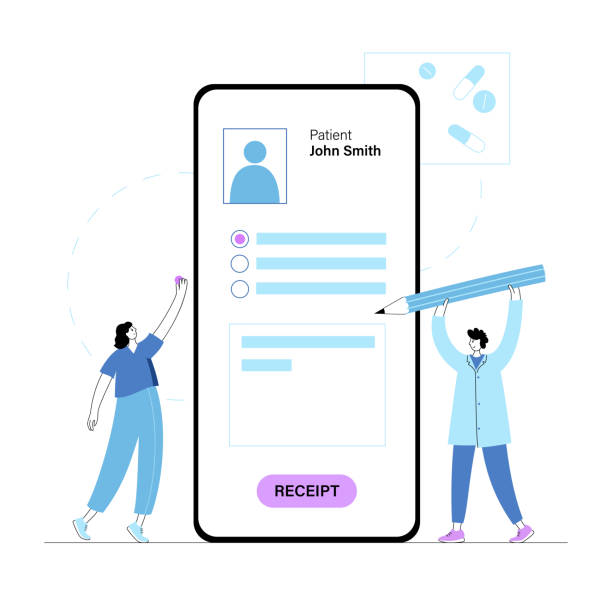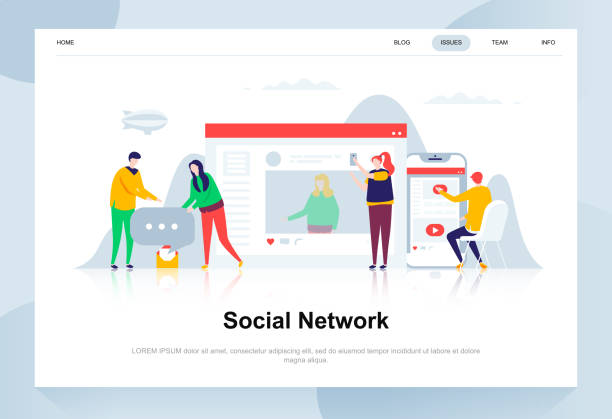The Importance of User-Friendly Website Design in Today’s World

In the current digital age, where competition for audience attention is at its peak, user-friendly website design is no longer an option, but an undeniable necessity.
This concept goes beyond the aesthetic appearance of a website and delves into how users can easily interact with the site, find the information they need, and have an enjoyable experience.
#User_Experience (UX) as the core of user-friendly design, ensures that every visitor can achieve their goals on the site without confusion or frustration.
On the other hand, #SEO (Search Engine Optimization) has an inseparable link with user-friendly design.
Search engines like Google rank websites that offer a better user experience higher, as their goal is also to provide the best results to users.
Therefore, a website with excellent User Interface (UI) and User Experience (UX) will have a greater chance of being seen in search results.
In addition to SEO, Conversion Rate is also heavily influenced by user-friendly design.
If users cannot easily fill out a form, add a product to their cart, or find contact information, they will quickly leave the site.
This means losing sales and communication opportunities.
A user-friendly website not only attracts visitors but also encourages them to stay, interact, and ultimately convert into a customer or loyal user.
This applies to educational, news, e-commerce, or even personal websites.
Investing in user-friendly website design means investing in the long-term success and sustainability of your online business.
This educational and explanatory section is the first step towards a deeper understanding of this vital concept and guides us towards its fundamental principles.
Did you know that poor online store design can drive away up to 70% of your potential customers? Rasaweb transforms your sales with professional and user-friendly e-commerce website design.
✅ Significant increase in sales and revenue
✅ Full optimization for search engines and mobile
⚡ [Get free consultation from Rasaweb]
Fundamental Principles of User-Friendly Website Design

After understanding the importance of user-friendly website design, it is necessary to delve into its fundamental principles, which form the main pillars of a successful user experience.
These principles are specialized guidelines that help designers and developers create websites that truly respond to user needs.
The first and most important principle is simplicity and clarity.
A website should not be overly cluttered or complex.
Users should be able to quickly understand the site’s purpose and effortlessly access the information or functions they need.
Using simple language, an organized visual layout, and removing unnecessary elements significantly contributes to this clarity.
The second principle is consistency and integration.
Design elements, including fonts, colors, buttons, and navigation, should be uniform throughout the website.
This consistency helps users quickly learn the site’s usage pattern and reinforces a sense of familiarity and trust.
For example, if a purchase button is green on one page, it should also be green on all purchase pages.
Immediate feedback is another vital principle.
Users should always be informed about the status of their interaction with the site; for example, after clicking a button, they should receive an indication of processing (such as loading) or confirmation of success (such as a “Your order has been placed” message).
This feedback prevents user confusion and uncertainty and gives them a sense of control.
Flexibility and efficiency are also important principles of user-friendly website design.
A site should be usable for both novice and experienced users.
Features like keyboard shortcuts or advanced options can be useful for professional users, while an intuitive user interface and step-by-step guides are ideal for newcomers.
Finally, error prevention and recovery assistance is a key principle.
A user-friendly website design should anticipate potential errors and prevent them (e.g., by validating forms).
In case of an error, clear messages and practical recovery guidance should be provided.
These specialized principles pave the way for creating an efficient and enjoyable website.
Understanding the Audience: Key to User-Friendly Website Design

No successful user-friendly website design will be achieved without a deep understanding of its target audience.
This analytical and educational section focuses on the importance of understanding user needs, behaviors, and expectations.
Before starting any design, key questions must be raised: “Who are my audience?”, “What are they looking for on my website?”, “How can they best interact with my content and services?”
Answering these questions forms the foundation of an effective design.
There are various methods for audience research.
One of the most common is creating Personas.
Personas are fictional characters, but based on real data, that represent typical users.
Each persona includes details such as age, gender, occupation, goals, challenges, and internet usage habits.
This helps designers put themselves in the users’ shoes and view the design from their perspective.
Surveys and interviews with real users are also valuable sources of first-hand information.
Analyzing existing data such as visitor statistics from similar or competitor websites (using tools like Google Analytics) can reveal user behavior patterns.
Understanding hidden user needs is also crucial for user-friendly website design.
Sometimes users don’t know exactly what they want, but designers can uncover these needs by observing their behavior or asking appropriate questions.
For example, users might not complain about slow page loading speeds, but data might show that they abandon the site because of it.
In the table below, some common user research methods and their benefits are mentioned:
| Method | Description | Benefits for User-Friendly Design |
|---|---|---|
| Persona | Creating fictional characters representing real users | User empathy, needs-based design decisions |
| Survey and Interview | Collecting quantitative and qualitative data from users | Identifying direct needs, problems, and expectations |
| User Journey Mapping | Visualizing the user’s path when interacting with the site | Identifying pain points and opportunities for experience improvement |
| Usability Tests | Observing users while they use the site | Discovering hidden navigation and efficiency issues |
With this analytical and data-driven approach, it can be ensured that user-friendly website design is based on real insights and not just guesswork.
This fundamental step paves the way for designing a logical and efficient information architecture.
Information Architecture and Navigation in User-Friendly Website Design

After understanding the audience, the next step in user-friendly website design is the logical organization of content through Information Architecture (IA) and designing an intuitive Navigation system.
Information Architecture deals with the arrangement, organization, and labeling of content in a way that users can easily find what they are looking for.
This specialized and guiding section addresses the importance of structuring content to create a smooth and effortless experience.
If the information architecture is weak, even the best content will get lost, disappointing users.
A strong information architecture is shaped by user needs.
This includes logical content categorization, creating clear hierarchies, and using clear and understandable naming for sections and pages.
For example, an e-commerce site should organize products based on specific categories (clothing, electronics, books) and have logical subcategories (shirts, pants).
Using Card Sorting and Tree Testing are common methods in information architecture that help designers find the best structure from the user’s perspective.
The navigation system is a guide that shows users where they are and how they can reach other destinations on the site.
Main menus, internal links, search bars, and breadcrumbs are all parts of the navigation system.
In user-friendly website design, the navigation menu should always be visible and consistent.
It is best to use a small number of main and understandable options in the menu, with more details placed in subcategories.
Powerful search functionality is also essential for sites with a large volume of content.
Ensuring that users can easily move from one page to another and always know their location on the site is a key factor in increasing user satisfaction and reducing the bounce rate.
These aspects of information architecture and navigation form the foundation of a successful user-friendly website design.
How much does losing business leads due to an unprofessional website cost you? Solve this problem forever with professional corporate website design by Rasaweb!
✅ Increased credibility and trust among potential customers
✅ Easier attraction of new business leads
⚡ Get free consultation now!
The Role of User Interface and Visual Aesthetics in User-Friendly Website Design

After designing the logical structure with information architecture, it’s time for User Interface (UI) and visual aesthetics, which not only make the website appealing but also play a vital role in user-friendly website design.
The user interface is what the user sees and interacts with; it includes buttons, forms, images, text, and the overall page layout.
Visual aesthetics and UI design not only improve the user experience but can also instill a sense of trust and professionalism.
A beautiful site encourages users to stay and explore further, even if only for a few moments.
In UI design, simplicity and visual harmony are very important.
Using a limited and attractive color palette, choosing legible and appropriate fonts, and sufficient white space (negative space) to reduce clutter, all contribute to improving the visual experience.
Buttons should be clearly distinguishable and their function evident.
For example, Call-to-Action buttons like “Buy Now” or “Sign Up” should be prominently displayed and guide users towards the desired action.
Responsive design and compatibility with various devices are also part of visual aesthetics, as a site should look good and function on any screen size.
In addition to aesthetics, interactive elements also play an important role in user-friendly website design.
Subtle animations, hover effects, and visual feedback during clicks or scrolling can make the user experience engaging and enjoyable.
However, care must be taken that these elements are not excessive and do not cause distraction or slow down the site.
The goal is for visual design to complement the user experience, not overpower it.
Choosing high-quality images and videos relevant to the content can enhance the site’s visual appeal and convey the message more effectively.
Ultimately, a strong user interface and captivating visual aesthetics convert visitors into loyal users and make them want to return to your site again.
This is an explanatory and engaging section that highlights the importance of attention to visual details in website design.
The Importance of Responsive Design for a User-Friendly Website Design

In today’s world, where users access the web from a wide range of devices, from large desktop computers to small smartphones and tablets, Responsive Design has become a vital necessity for any user-friendly website design.
This specialized and informative section addresses the importance of this approach, which ensures your website provides the best user experience on any screen size.
The absence of responsive design can lead to losing a large portion of the audience, especially those using mobile devices.
Statistics show that more than half of global web traffic originates from mobile devices.
Responsive design means that the website’s layout, images, and content elements automatically adjust to the user’s device screen size.
This ensures that users do not need to zoom, scroll horizontally, or struggle to find information on a cluttered page.
A responsive site provides a smooth navigation experience and easy readability across all platforms.
This is not only crucial for user satisfaction but also of high importance for SEO and search engine rankings.
Google and other search engines prefer mobile-friendly websites and rank them higher in search results for mobile devices.
Implementing responsive design involves using fluid grids, flexible images, and media queries in CSS.
These techniques allow the website to intelligently react to screen size changes.
A user-friendly website design that doesn’t work well on mobile is like a store whose door is closed to half of its customers.
In recent years, the focus on “Mobile-First Design” has also increased, meaning designers first design the mobile version of the website and then develop it for larger screens.
This approach ensures that the mobile experience is provided in the best possible way, as most users access the site via mobile.
Paying attention to responsive design is an essential step to ensure accessibility and success in the digital age.
Optimizing Site Performance for a User-Friendly Experience

Website loading speed is one of the most critical factors in user-friendly website design, directly impacting user experience, conversion rates, and SEO ranking.
In this analytical and explanatory section, we examine methods for optimizing site performance.
Today’s users expect websites to load quickly; even small delays of a few hundred milliseconds can lead to frustration and site abandonment.
A slow site not only drives users away but also receives less attention from search engines.
Several factors influence site loading speed.
One of the most important is file size.
Optimizing images (compressing without significant quality loss), compressing CSS and JavaScript files, and reducing the number of HTTP requests can significantly increase speed.
Using a Content Delivery Network (CDN) also helps accelerate content delivery to users worldwide, as content is served from the closest server to the user.
Also, caching content in the user’s browser makes the site load faster on subsequent visits.
Furthermore, choosing appropriate hosting and optimizing server-side coding also play key roles.
Using clean, efficient code without unnecessary plugins helps reduce server processing time.
Tools like Google PageSpeed Insights, GTmetrix, and Pingdom Tools can help you analyze site performance and identify weaknesses.
In the table below, some key factors for site performance and their impact on a user-friendly experience are mentioned:
| Optimization Factor | Description | Impact on User-Friendly Experience |
|---|---|---|
| Image Optimization | Reducing image file size without significant quality loss | Reduced page load time, visual improvement |
| Code Compression | Removing whitespace and extra characters from CSS/JS | Reduced file size, faster loading |
| Using CDN | Distributing content across servers closest to the user | Increased content delivery speed, high responsiveness |
| Enabling Browser Caching | Storing files in the user’s browser for subsequent visits | Much faster loading on repeat visits |
User-friendly website design should include a strong strategy for performance optimization.
A fast site not only keeps users satisfied but also helps your business goals, as more users will stay on the site and engage more.
Accessibility: Key to User-Friendly Website Design for All

A crucial and often overlooked aspect of user-friendly website design is Accessibility.
Accessibility means designing and developing websites in a way that people with disabilities can easily use them.
This is an educational and guiding approach that emphasizes the principles of inclusivity in web design.
Millions of people worldwide have various visual, auditory, motor, or cognitive disabilities that may face serious challenges when using inaccessible websites.
By designing accessibly, you not only serve a larger community of users but also comply with legal requirements (in many countries) and enhance your brand’s reputation.
Web accessibility principles are published by the World Wide Web Consortium (W3C) in the form of Web Content Accessibility Guidelines (WCAG).
These guidelines are based on four fundamental principles:
- Perceivable: Information and user interface components must be presented to users in a way they can perceive.
For example, providing alternative text (alt text) for images for Screen Readers and using captions for videos. - Operable: User interface components and navigation must be operable.
For example, full keyboard navigation for individuals who cannot use a mouse, and preventing automatic activation of content (such as autoplaying videos). - Understandable: Information and the operation of the user interface must be understandable.
Using simple and clear language, consistent navigation design, and providing understandable error messages and recovery guidance fall into this category. - Robust: Content must be robust enough to be interpreted by a wide range of user agents, including assistive technologies, and future technologies.
This includes using semantic and standard HTML code.
A user-friendly website design that pays attention to accessibility includes items such as sufficient color contrast for text and background, correct use of semantic HTML tags (like heading tags and list tags), and providing font resizing capabilities.
By considering accessibility from the initial design stages, you can ensure that your website will be usable and enjoyable for all users, regardless of their abilities.
This approach is not only ethical but also vital for the long-term success of your site and is rightly considered an integral part of a modern user-friendly website design.
Does your current website showcase your brand’s credibility as it should? Or does it drive away potential customers?
Rasaweb, with years of experience in professional corporate website design, is your comprehensive solution.
✅ A modern, beautiful website tailored to your brand identity
✅ Significant increase in lead generation and new customers
⚡ Contact Rasaweb now for a free corporate website design consultation!
Continuous Testing and Review in User-Friendly Website Design Process

The user-friendly website design process is not a one-time task, but a continuous cycle of design, testing, feedback, and review.
This guiding and thought-provoking section addresses the importance of Usability Testing and continuous reviews to ensure the best user experience.
Do you truly know how your users interact with your site? Are your assumptions about user behavior correct? Only through real testing can these questions be answered and the design’s strengths and weaknesses discovered.
Usability testing involves observing real users while they perform specific tasks on the website.
This can be done in a controlled laboratory environment or remotely.
The main goal of these tests is to identify points where users encounter difficulties, get confused, or cannot achieve their goals.
Direct feedback from users provides the most valuable data for improving user-friendly website design.
Even with the best designers and adherence to all principles, there may be parts of the site that are challenging for real users.
In addition to formal usability tests, there are other methods for collecting feedback and reviewing:
- Web Analytics: Using tools like Google Analytics to monitor user behavior, such as navigation paths, time spent on pages, bounce rates, and conversion rates.
These data can reveal general patterns. - Heatmaps & Session Recordings: These tools show where users click, scroll, and how they interact with page elements.
Session recordings also allow for precise observation of user behavior. - On-site Surveys: Asking short, targeted questions to users while they visit the site can provide immediate feedback on specific parts of the site.
- A/B Testing: Comparing two different versions of a page or element to determine which performs better.
This method is very useful for continuous optimization.
A truly user-friendly website design never stays static.
As user expectations, technologies, and competitors change, the website must be continuously reviewed and improved.
The fundamental question is: “Are we learning enough from our users and are we willing to change based on those learnings?” This iterative and data-driven approach ensures that your site is constantly evolving and providing the best possible experience to users.
The Future of User-Friendly Website Design and Final Conclusion

At the end of this comprehensive journey into user-friendly website design, it is necessary to look at the future and then provide a final conclusion.
This informative and analytical section explores emerging trends in web design that can further revolutionize the user experience.
One of the most important of these trends is Artificial Intelligence (AI) and Machine Learning (ML), which are changing how we interact with websites.
From advanced chatbots to personalized content recommendations, AI can dramatically make the user experience smarter and more relevant.
Another trend is Voice User Interfaces (VUIs) and Augmented Reality (AR) and Virtual Reality (VR).
Although still in their early stages in web design, these technologies have great potential to create entirely new and immersive user experiences.
Imagine a website where you can interact with it using your voice or view a product in 3D in your home space.
These are just a glimpse of the future that awaits us.
Also, sustainability and responsibility in web design have gained increasing importance.
Designing websites that are more energy-efficient (with optimized coding and less use of heavy animations) and also address social and ethical issues (such as user privacy and combating misinformation) are important future trends.
This is not only beneficial for the environment but also helps increase user trust.
In conclusion, user-friendly website design is the backbone of success for any online entity.
This concept goes beyond a beautiful appearance; it is a comprehensive approach that includes a deep understanding of users, logical content organization, attractive and efficient UI design, optimization for speed and accessibility for all, and a commitment to continuous testing and review.
Each of these elements, individually and together, contributes to building a digital experience that not only satisfies users but also achieves your business goals.
In a world where websites are the main gateway to customers, information, and communication, investing in a user-friendly website design is not only smart but essential.
The future belongs to websites that place users at the center of all their design decisions.
Frequently Asked Questions
And other services of Rasaweb Advertising Agency in the field of advertising
Smart Sales Automation: A professional solution for online growth focusing on precise audience targeting.
Smart Direct Marketing: A specialized service for improving SEO ranking based on attractive user interface design.
Smart Marketing Automation: An effective tool for digital branding with the help of real data.
Smart Advertorial: A fast and efficient solution for campaign management focusing on custom programming.
Smart Sales Automation: Designed for businesses looking to analyze customer behavior through SEO-driven content strategy.
And over hundreds of other services in the field of internet advertising, advertising consultation, and organizational solutions
Internet Advertising | Advertising Strategy | Advertorial
Resources
Principles of User-Friendly Website Design
Guide to Successful Website Design
Key Tips for Online Success
Improving User Experience and Increasing Sales
? Are you ready to transform your business in the digital world? Rasaweb Digital Marketing Agency, specializing in professional website design, SEO, and content marketing, offers a comprehensive solution for your growth and visibility. With us, discover the true potential of your brand.
📍 Tehran, Mirdamad Street, next to Bank Markazi, Kazeroun South Alley, Ramin Alley, No. 6


